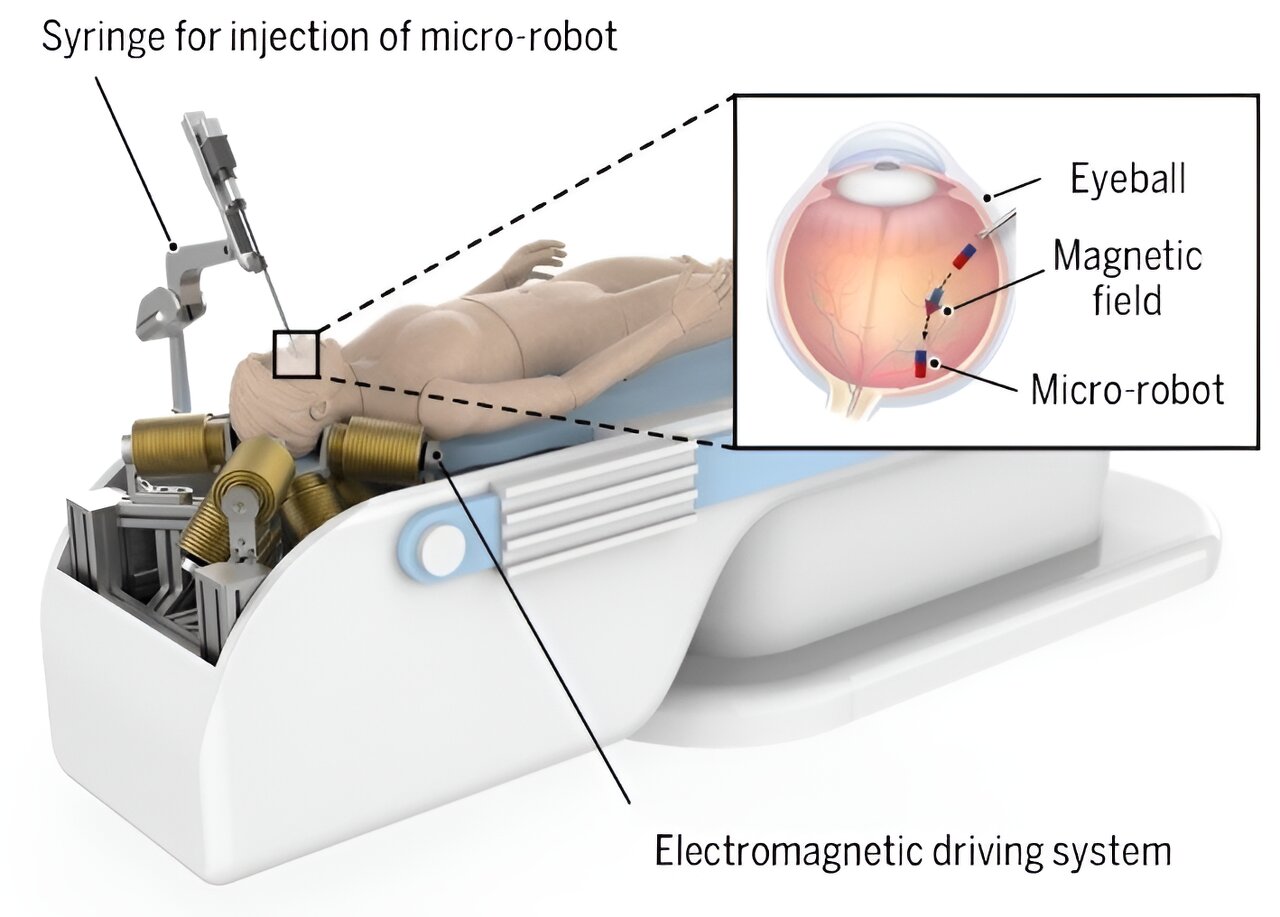#Researchers develop electromagnetic driving system to enhance intraocular microsurgery


A research team has presented a novel electromagnetic driving system that consists of eight optimized electromagnets arranged in an optimal configuration and employs a control framework based on an active disturbance rejection controller (ADRC) and virtual boundary. Electromagnetic driving systems were proposed for the flexible 5-DOF magnetic manipulation of a micro-robot within the posterior eye, enabling precise targeted drug delivery.
The team published their findings in Cyborg and Bionic Systems on Mar 23, 2024.
Intraocular microsurgery has witnessed a transition from the utilization of conventional handheld surgical tools to the adoption of robot-assisted surgery, owing to its ability to effectively mitigate the surgeons’ physiological tremors during procedures and achieve precise motion scaling.
However, with increasing proximity to the posterior eye, robot-assisted devices may inadvertently position the instruments too deeply or exert excessive scleral forces under the surgeon’s control, which can traumatize the retina or sclera and result in hemorrhages or even severe injury. The above causes have led to the incidence of intraoperative and postoperative complications ranging from 2% to 30%.
These 5-DOF electromagnetic driving systems pose a distinct actuation paradigm compared with the existing robotic-assisted systems. It typically employs a force-controlled mode rather than a position-controlled mode, which makes the micro-robot a safer instrument for interacting within the posterior eye.
In force-controlled mode, the electromagnetic driving system can effectively mitigate the risk of causing irreparable retinal damage by imposing limits on interacting forces, even in situations involving patient movement or system failure. However, it is challenging to generate high-intensity magnetic fields and magnetic forces within a large workspace.
Therefore, the design optimization of the system configuration and electromagnet parameters for providing a high magnetic field and magnetic force generation capacity has been emerging and attracting broad attention. Moreover, the study of suitable control frameworks is also necessary because of disturbances introduced by many factors such as inaccurate modeling of electromagnetic coils, changes in interaction forces in the liquid environment.
To tackle the above-mentioned issues, the researchers present a novel electromagnetic driving system for 5-DOF magnetic manipulation in intraocular microsurgery. Two-step design optimization attempting to obtain optimal system configuration and electromagnet parameters have been presented and implemented to enhance the capacity for sustained work.
With the proposed configuration optimization procedure and the multi-objective optimization of the electromagnets, the system can perform a more precise and stable manipulation and has obtained a stronger capacity for sustained work. In addition, the system utilizes a control framework incorporating the ADRC controller and virtual boundary to enhance robustness and security in intraocular microsurgery.
Simulation and analysis have been performed to evaluate the influences of the proposed design optimization and control framework. The performance evaluation and trajectory tracking performance tests in different operation modes are implemented with the presented control framework incorporating the ADRC controller and virtual boundary, validating its performances and effectiveness compared with PID and TDE controllers.
The results indicate a significant decrease in both the maximum error and maximum RMS error during disturbance-free performance tests, with reductions ranging from 47.1% to 65.4% and 62.7% to 84.4%, respectively. Besides, the performance tests conducted in this work have additionally taken into account disturbances that were overlooked by other related works.
The obtained results demonstrate the system’s remarkable robustness in the presence of disturbances, as evidenced by the maximum error and RMS error being below 172.2 and 35.8 μm, respectively.
Looking to the future, the researchers will employ a more accurate magnetic field-current model to further enhance the positioning accuracy and enhance usable workspace within the open volume. Furthermore, future work will also explore implementing fiber Bragg grating (FBG)-based real-time detection of electromagnet temperatures, aiming to enhance safety measures.
The research team includes Yangyu Liu, Dezhi Song, Guanghao Zhang, Qingyu Bu, Yuanqing Dong, and Chaoyang Shi from the University of Tianjin, Tianjin; and Chengzhi Hu from the Southern University of Science and Technology, Shenzhen.
Yangyu Liu et al, A Novel Electromagnetic Driving System for 5-DOF Manipulation in Intraocular Microsurgery, Cyborg and Bionic Systems (2023). DOI: 10.34133/cbsystems.0083
Provided by
Beijing Institute of Technology Press Co., Ltd
Citation:
Researchers develop electromagnetic driving system to enhance intraocular microsurgery (2024, May 31)
retrieved 31 May 2024
from https://medicalxpress.com/news/2024-05-electromagnetic-intraocular-microsurgery.html
This document is subject to copyright. Apart from any fair dealing for the purpose of private study or research, no
part may be reproduced without the written permission. The content is provided for information purposes only.
If you liked the article, do not forget to share it with your friends. Follow us on Google News too, click on the star and choose us from your favorites.
If you want to read more Like this articles, you can visit our Science category.




